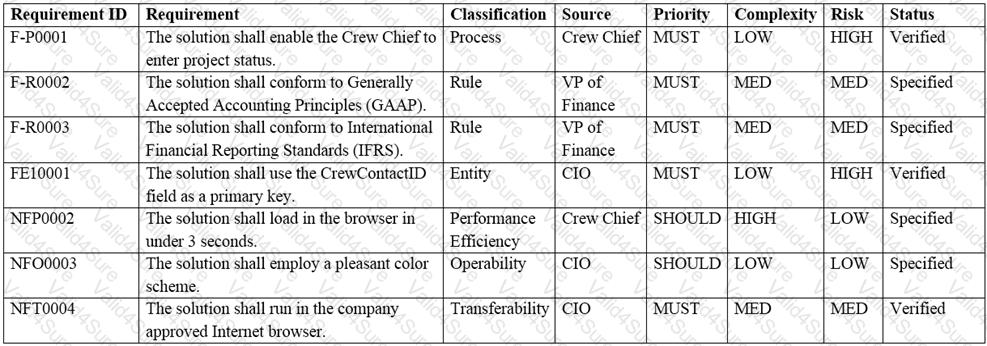CBAP Exam Dumps - Certified Business Analysis Professional
You are the business analyst for your organization and preparing to complete the requirements elicitation activities. Your manager wants to know when the requirements elicitation process will be completed.
Which of the following responses best describes the nature of the requirements elicitation process?
You are the business analyst for your organization and are preparing for the conduct elicitation activity. You'll need several stakeholders' roles as you prepare for this activity in your organization.
Which one of the following stakeholders may be responsible to dictate that a specific process or technique be
followed during your requirements elicitation activities?
Sally is the business analyst for her organization. Sally and her business analysis team is currently using a business analysis approach to determine what the competition of her organization is offering prospective clients. She is trying to identify solutions to increase revenue by remaining competitive with the competition.
What business analysis approach is Sally and her business analysis team using?
An insurance company wants to increase sales by 15% and customer retention by 10% within 1 calendar year.
Various strategies to achieve this were considered and a restructure to the existing pricing model is selected to help achieve these goals.
A business analyst (BA) works with stakeholders such as actuaries, product specialists, sales staff, risk managers, and underwriters who agree to applying varying levels of discounts to customers based on:
•Total annual premium the customer has with the company (Financial worth)
•Time with the insurance company (Loyalty)
Various financial models are considered but the stakeholders agree that an initial applicable discount is determined based on the customer's overall premium:

The percentage of the maximum possible discount available to the customer is adjusted based on time with the company:

As the new pricing structure was being implemented, the chief executive officer (CEO) of the company wanted to change the premiums and associated discounts offered to customers. The BA investigated the cost, anticipated benefits and the length of time the change would likely take to complete before presenting the results back to the CEO.
What type of analysis has the BA just conducted?
A team of business analysts (BAs) were assigned to review an enhancement request that would involve changes in a stockroom and the inventory of products. The changes will impact several groups of people and the amount of savings is in excess of $1 million dollars. The recommended process improvement will be presented to management for approval.
What should the team do first?
Company A is a nation-wide leader in commercial demolition. Having just celebrated its 100th year of operations, the company decided to begin doing work internationally. The current system used for reporting company finances is unable to keep pace with the potential demands of doing work in geographically dispersed locations. Therefore, the company decided to replace its client-based Profit & Loss (P&L) reporting system with a more robust, web-based system. This will ensure transparency across the organization and enable better decision making.
The business analyst (BA) at Company A has recently completed several rounds of elicitation to determine the requirements for the new, web-based system. Over 1250 requirements were elicited. An initial Requirements Traceability Matrix (RTM) has been drafted, and a subset of the RTM can be seen below:

The BA is working on identifying additional improvement opportunities based on these requirements. Which of the following improvement opportunities is reflected in Requirement ID NFP0002?
A business unit of a transnational manufacturer wants to implement a robust process for addressing integrity- critical equipment deterioration incidents. Timely and complete resolution of such incidents is vital for the business unit’s continuous safe and profitable operation. Treating each incident involves many employees from different departments extensively collaborating and exchanging information. That information is spread across multiple systems having their access limited to particular user groups. With the current manual process, some incidents get forgotten and remain unresolved for years.
The project’s Sponsor is an Equipment Integrity and Reliability Advisor, who moved into this position from
another business unit. That business unit implemented a proprietary application to integrate the information and to assist in tracking and managing the incidents. Having a positive experience with the application, the Sponsor is suggesting to customize it and reuse in the new business unit.
The business unit’s Enterprise Architect (EA), who is responsible for assessing solution options and presenting them to executive decision makers, has a few concerns with adopting the existing application. The application uses point-to-point interfaces with other data sources whereas the business unit’s target architecture relies on a data warehouse-based integration. Moreover, the two business units use different legacy systems, as well as different front-end implementation technologies. Additionally, the existing application is monolingual, while the business unit needs user interfaces and some data to be presented in two languages. With all of this, it may be easier to build a new application from scratch than to customize the existing one. To understand which option is better, the EA asks a business analyst (BA) to define business requirements.
With the team ready to consider design options, they are reviewing the following requirement: "Appropriate stakeholders shall be timely and reliably notified on incident-related events."
What quality criteria does this requirement fail to satisfy?